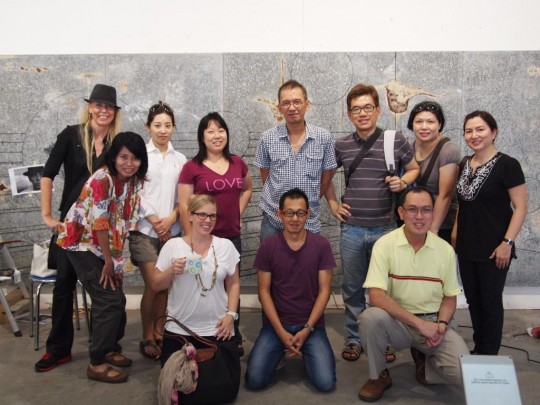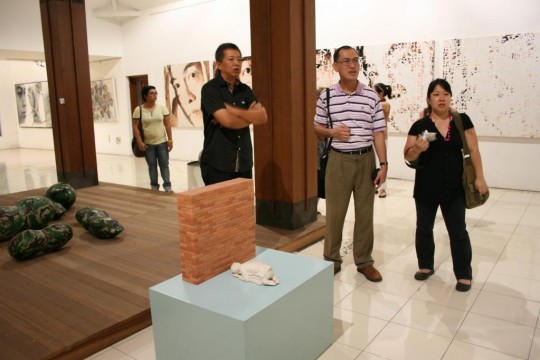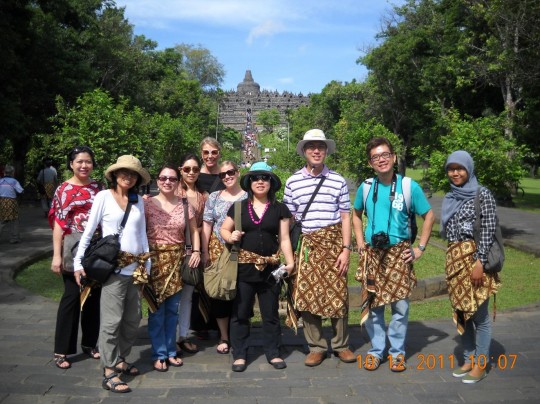by Rohaya Binte Mustapha –
From 8th to 12th December 2011, eight students from the Master of Art in in Asian Art Histories Programme and programme leader Jeffrey Say embarked on a study trip to Jogjakarta, Indonesia. The aim of such trips which form an integral part of the programme is to expose students to specific social and cultural contexts, to open up learning outside of the academic environment and to create networking for research opportunities. The trip was short but well scheduled in order to take in visits to artists’ studios, collectors’ galleries and the Biennale Jogja XI (Biennale Jogja has been running since 1988).

Students and Programme Leader Jeffrey Say at the studio of established Indonesian artist Agus Suwage (standing, centre) accompanied by their guide, noted Indonesian curator and writer Enin Supriyanto (kneeling, centre)
Jogjakarta (or Yogyakarta) was selected because it is one of the important centres of art in Indonesia. It is a city which has more to say about Indonesian contemporary art than Jakarta, Bandung and Bali. And it is a city teeming with artists and is seen as the main contributor to the Indonesian contemporary art scene. It is not without basis then that Indonesian artist Eko Nugroho has been quoted to have said that if you throw a stone in Jogjakarta, you are bound to hit an artist!
Langgeng Art Foundation, a contemporary art foundation founded by Dedi Irianto in 2010, arranged for the land tours and all the special arrangements which brought the group to look not just at Indonesian art but also right into the private homes of some very established and well known artists and significant Indonesian art collectors. The Foundation’s main role is to facilitate various kinds of art creation, presentation and discussion and indeed collaboration within Indonesia and with overseas counterparts. Enin Suprianto, a noted Indonesian curator who was then director at Langgeng was at hand to accompany the group to some of the venues and interpret when the need arose. He also generously engaged the group with his in-depth understanding and views about Indonesian art. The arrangements were thoughtfully organised to give the students as much exposure to the Indonesian context within the constraints of time.
The group visited the private homes and studio galleries of established artists Agus Kurniawan, Agus Suwage, S.Teddy and Nasirun. The sprawling spaces in which these established artists have at their disposable to create art, invite fellow artists over for social and artistic discourses, and spacious wall space to display art, generated awareness on the importance of one of the most basic needs of an artist, that is, space for solitary contemplation as well as space for communal artistic and cerebral exchanges. Artist Nasirun is in fact unstoppable in using even the pavements outside his cluster of home-galleries to express his artistic energy. The authorities and his neighbours appear not to take any action to restrain his artistic encroachments into public space.

At the home of well-known Indonesian artist Nasirun
The group also visited the private galleries of collectors Dr Oei Hong Djien and Deddy Irianto. Dr Oei’s collection of the early modernists like S. S. Sudjojono, Hendra Gunawan and Affandi is probably the most significant in private hands. Dedi Suprianto’s modesty in claiming to collect more contemporary works because they are more affordable belies the extensive collection spread out in his private gallery. Although the two collectors apply different tastes and rationale in their collecting, what surfaces as common is that these two significant collectors are supporters of Indonesian artists. There is also dialogue between artists and collectors and even curators, a situation which seems peculiar to the Indonesian context.

At the private gallery of Indonesian collector Deddy Irianto
Cemeti Art House was another destination not to be missed by art history students. Cemeti Gallery was founded in 1988 by artist couple Mella Jaarsma and Nindityo Adipurnom and is considered an institution in its own right in the Indonesian art world. It plays a major role in stimulating the development and enthusiasm for contemporary art and bringing Indonesian artists into international art forums. Mella was around to host the group around the very tastefully rustic place and explain about the art residencies hosted by the Cemeti Art Foundation which also accepts art writing and is not limited to art making. Commercial art galleries Sangkring Art Space and Syang Art Space were also included in the itinerary. A visit to the Indonesian Visual Art Archives (IVAA) housed in a standalone building in a rather rustic neighbourhood was also an eye opener as to what an art archive is about as Singapore has yet to have something equivalent.
The visit to Jogjakarta was also specially timed to catch the 11th Jogjakarta Biennale. It was also the first in a series (which will take 10 years to complete) which attempts to culturally engage another country located near the equator. This first is named Shadow Lines: Indonesia meets India. The narrow focus of the Biennale on religiosity as perceived in everyday life and its interpretations by Indian and Indonesian artists was a strategy which helped to bring disparate art works in terms of form and material into dialogue with one another. It was interesting to see another approach to curating a Biennale, in this case, one which gave prominence to local artists.
Langgeng art Foundation also made sure that the group dined well in a variety of locations. One of the dining stops was right in the middle of a padi field which made it a rather aesthetic experience. Even the need to buy souvenirs was carefully included as part of the intinerary. The visit to the world heritage site of Borobudur which is a monumental work of art in itself was a special highlight of the trip. A most knowledgeable and animated guide narrated significant myths and historical aspects of the grand monument. It helped the group members contemplate the many connections which contemporary Indonesian art still makes with its rich histories.

Getting ready to climb Borobudur (background), one of the great wonders of the world
The experiential nature of such a study trip indeed drives home the point that actual contact with the people and the contexts they live in has much to contribute to understanding art histories. It offers an invaluable impression and provides opportunities to make contacts with other art communities.
This article was written by Rohaya Binte Mustapha, who graduated from the MA Asian Art Histories Programme in 2012.

